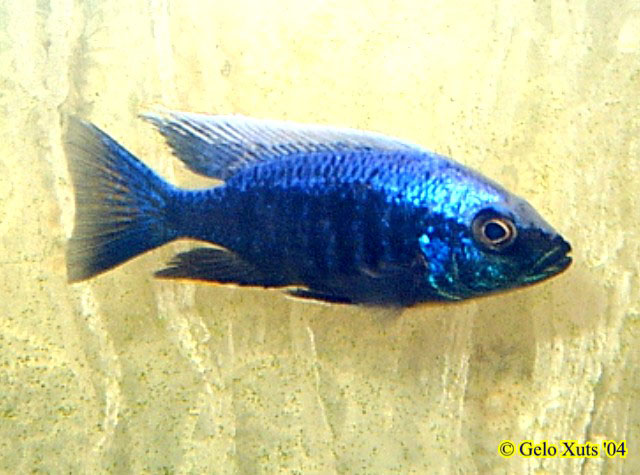| Cichlidae (Cichlids), subfamily: Pseudocrenilabrinae |
| 10.54 cm SL (male/unsexed); 8.3 cm SL (female) |
|
benthopelagic; freshwater; depth range 10 - 30 m |
| Africa: Endemic to Lake Malawi, occurring around Likoma and Chizumulu islands, at Cobwe and between Makonde and Manda. |
|
Dorsal spines (total): 15-17; Dorsal soft rays (total): 9-12; Anal spines: 3-3; Anal soft rays: 8-9. Diagnosis: 3 distinct spots on flank (Ref. 47113, 57549). Supra-pectoral spot about 1.5 times supra-anal spot and in contact with the upper lateral line; supra-anal spot separate from upper lateral line; no narrow black submarginal band in dorsal fin (Ref. 57549). Male breeding coloration: black ventral body and blue to white blaze on dorsum above lateral line (Ref. 47113, 57549), until posterior end of dorsal fin and continuing onto upper margin of caudal fin (Ref. 57549). 15-18 gill-rakers; 27 dorsal rays in total; caudal peduncle length 5.9 times in SL; caudal peduncle depth 8.1 times in SL (Ref. 47113). Female C. trewavasae cannot be reliably distinguished from those of C. verduyni (ref. 57549).
Description: dorsal snout profile straight; gape inclination of mouth about 35° to horizontal; jaws isognathous (Ref. 57549). Teeth on dentary and premaxilla in 2-4 rows (Ref. 57549), outer tooth row containing unequally bicuspid teeth, inner rows unicuspid or unequally tricuspid in females and immature males, outer row teeth with large unicuspid teeth in mature males (Ref. 47113, 57549). Lower pharyngeal jaw small, dentigerous area notched posteriorly, with small bicuspid teeth; gill-rakers on ceratobranchial short and broad; 1-3 pored scales posterior to lateral line; 2-3 scale rows on cheek (Ref. 57549). 32-34 scales in longitudinal series (Ref. 47113).
Coloration: breeding males: head black; blue/white interorbital blaze extending posteriorly to caudal fin; lateral portion of body dark blue/black ground color with light blue and gray highlights; breast and belly black; blue/white blaze on dorsum above lateral line until posterior end of dorsal fin; proximal 2/3 of spinous dorsal fin blue/black with light blue highlights, distal 1/3 white; proximal 3/4 of anterior 3 membranes of rayed portion of dorsal fin blue/black, distal 1/4 white, posterior membranes blue/black with orange tips; proximal 3/4 of caudal fin black, distal 1/4 dark gray; anal fin black with white/orange tips; pelvic fin black with blue leading edge; pectoral fin with black rays and clear membranes (Ref. 57549).
Females: head gray; silver cheeks and opercles with dark blue opercular spot and white throat; lateral portion of body with 3 black spots; supra-pectoral spot below 9-11th scale not in contact with upper lateral line and about 1.5 times size of supra-anal spot; supra-anal spot at 23-25th scale above and in contact with lower lateral line and covering 2-3 scales; caudal spot same diameter as supra-anal spot on caudal base and onto peduncle; 3 vertical bars between supra-pectoral spot and dorsal-fin origin; body above upper lateral line gray, below upper lateral line silver with posterior margins of scales blue; belly and breast white; spinous portion of dorsal fin gray with white lappets and orange tips, and rayed membranes gray with orange/brown spots; caudal fin gray; anal fin hyaline with gray bar located approximately 2/3 of distal portion; pelvic fin hyaline with first ray and membrane gray; pectoral fin clear (Ref. 57549). |
| Inhabits the sand/rock interface (Ref. 47113, 57549) where sand and rocks are found in almost equal proportions (Ref. 47113). Territorial males construct a bower next to a rock, under which spawning takes place; females normally occur in small groups rarely numbering more than 10 individuals and remain close to the bottom (Ref. 57549). Mouthbrooding females remain closer to the bottom than foraging females and sometimes form small groups (Ref. 47113). Both males and females feed on plankton in the water column near the bottom and on benthic invertebrates (Ref. 57549). |
|
Least Concern (LC); Date assessed: 22 June 2018 Ref. (130435)
|
| harmless |
|
Source and more info: www.fishbase.org. For personal, classroom, and other internal use only. Not for publication.

